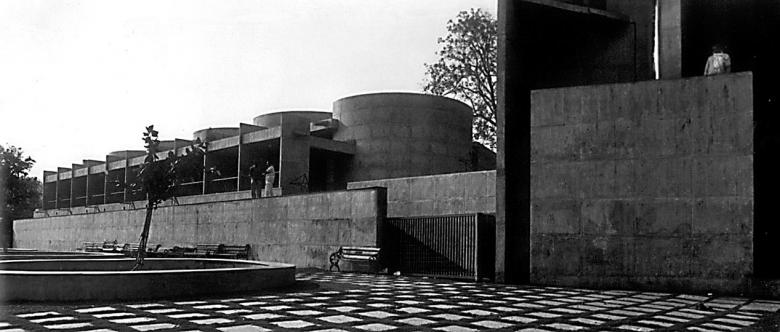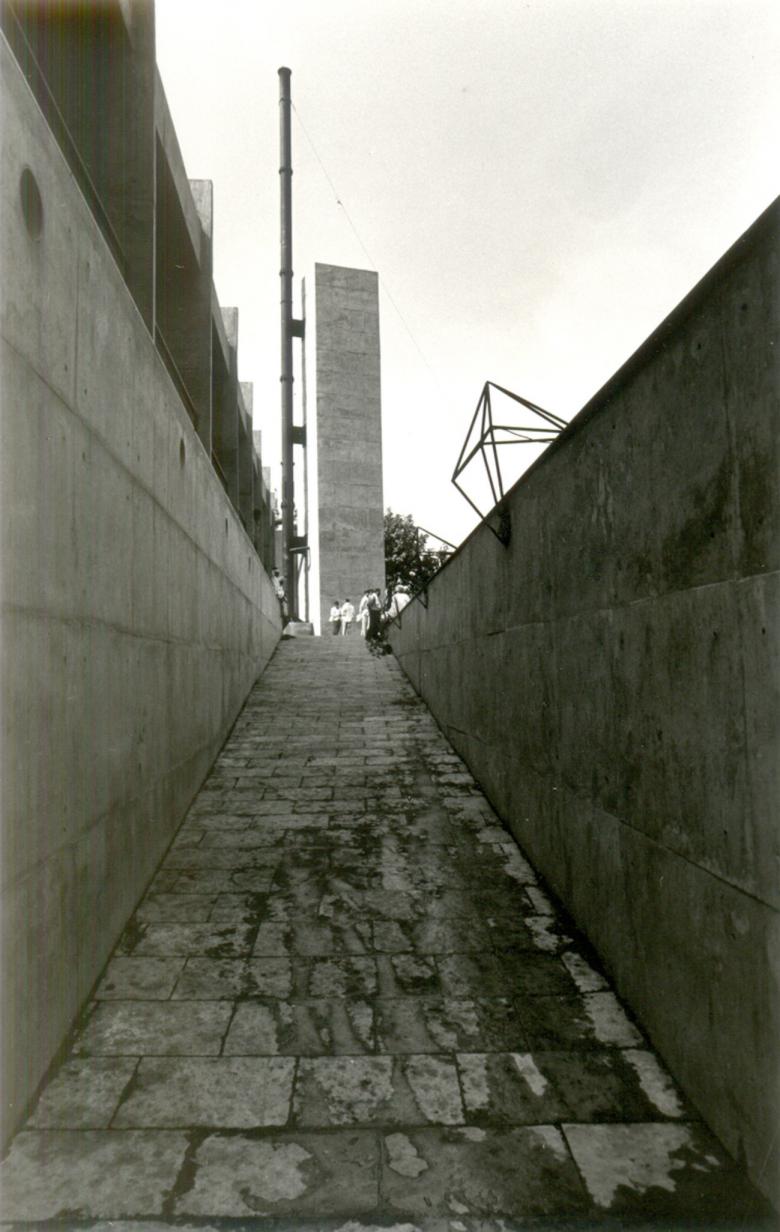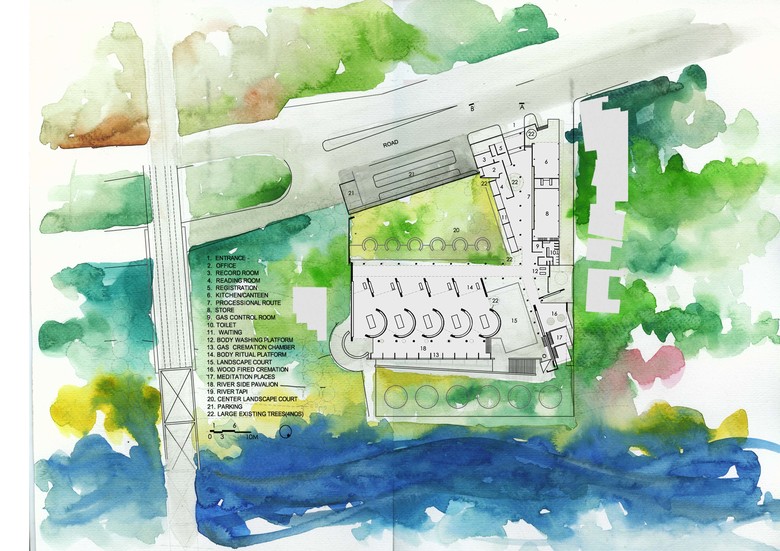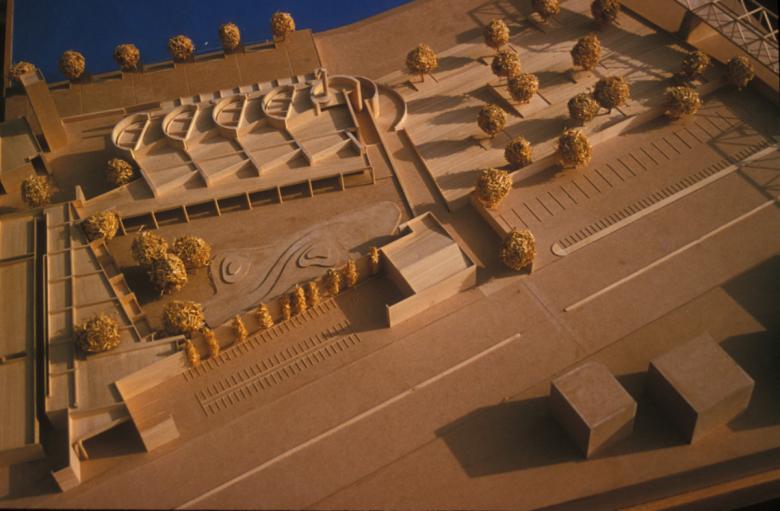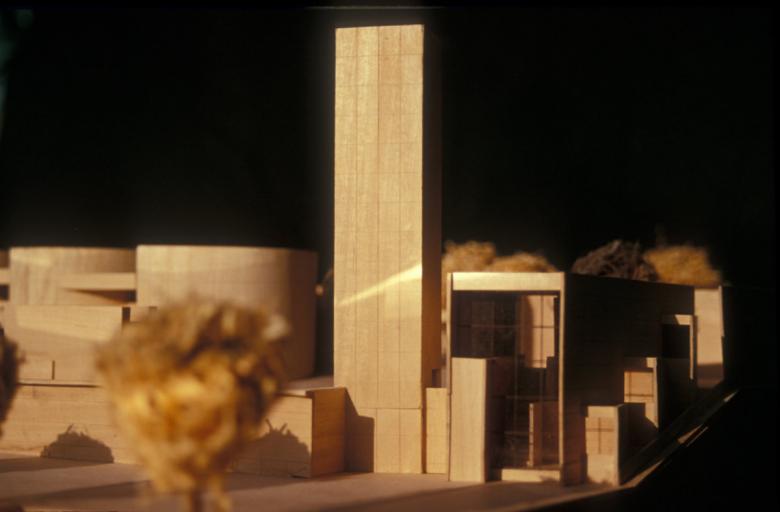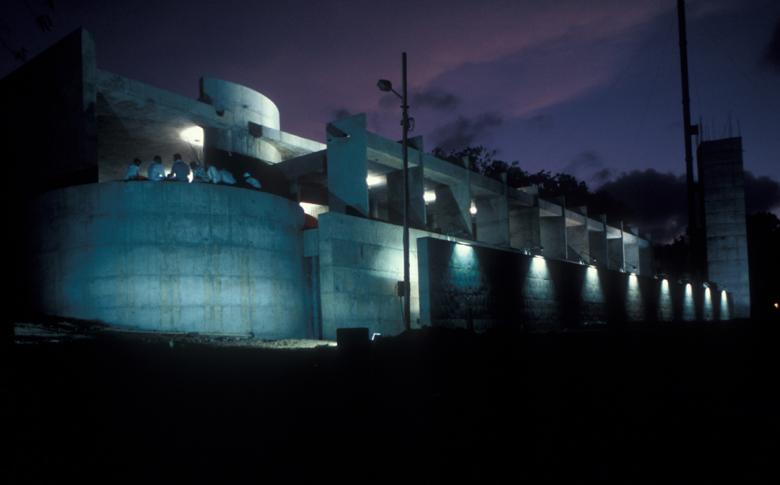Ashwinikumar Crematorium
Surat, India
Although there is no archetypal form for a crematorium, the cremation place is marked by a pavilion-like structure standing in open ground outside the city limits. However, in most cities today, these sites have been engulfed by urban growth, making the pavilion lose its symbolic significance.
The Ashwinikumar Ghat (crematorium) is located on the banks of the river Tapi in Surat – a large city towards the West of India.(Photo 7) Situated in the Western state Gujarat, Surat is a busy business centre trading for the diamond and textile industries. In a span of four years between 1992 and 1996, Surat was ravaged repeatedly by terrible natural and man-made calamities: A violent spate of communal riots in 1993. A severe flood in the river Tapi, resulting in a catastrophic epidemic in 1994, which may be identified as the dreaded plague. Severely criticized for its filth and squalor, the city finally woke up to its conditions; a competent administration succeeded in mobilizing the citizens to the extent that within a span of two years, the city was transformed. During this period, the competition for a new crematorium was launched, resulting in this entry being selected from among 28 other entries.
The first gesture of the design was to re-articulate the essential identity of the crematorium in the context of its urban setting. This was done by creating a large clearing. This plane was isolated from the surrounding building and road by structures incorporating all auxiliary functions. The site thus became introvert, looking only in the direction of the river. On this plane were then arranged the functions that would fulfill the essential rites of cremation – the basic lines that structured the building being drawn from the skewed angles of the site.
While respecting the strong traditional beliefs and values connected to cremation, the project not only attempts to find a valid architectural expression for a crematorium in an urban context, but also attempts to eloquently navigate the changing role of religion in modern society. Although connected ritually to Hinduism, the building is secular in nature, open to all, irrespective of religious beliefs.
On one side, the chambers open into a landscaped courtyard where the gathering can spill over. The landscaping is sparse and maintenance free(Photo 4), lawns defined by brick paving, and gathering areas interspersed with large trees that blossom in during the passing season.
On completion of a ceremony, the relatives and friends leave the grounds not by returning along the entrance, but by climbing down the ramp on the riverside, sometimes taking a dip in the river, and climbing back on to the road from the bank before returning homewards, thereby traversing the cycle symbolic of life (Photo 2). This is also the place where one sees the building for the first time – so far the building has always formed the ‘backdrop’ of the events it holds and can therefore only be experienced, never ‘seen’.
Built in 1999, it has already been used for over 80,000 funerals; (Photo 8) in that time it has been submerged in a meter of flood water – during which ceremonies were not stopped.
The Mythology
With close to 750 million followers Hinduism is the oldest living religion in the world – with the majority of its followers located in the Indian subcontinent. While the paradigmatic notions about nature of the world and man’s position in it are established and accepted. Unlike Islam and Christianity, Hinduism does not have a codified system of practice. The practice of the religion tends to vary greatly from community to community and region to region.
One practice that is commonly followed by a majority of Hindus is that of cremating the dead. This custom is in tune with the belief of the immortality of the soul, or jive, and the temporal nature of the ‘dehya’ (body) it dwells in. It is believed that by cremating the body the soul is released from the desire for the body and thus prepared for ‘moksha’ (emancipation). Cremation is an immediate ceremony, a symbolic farewell by the soul to the body, before being liberated or reincarnated. Traditionally the site consecrated as a cremation ground, the ‘Smashya Ghat’ has to certain symbolic requirements: generally it is located adjoining a water body, often a river, away from human settlement, with a small temple adjoining it.
It is said that to save himself the sun God himself from his own heat created the Tapi, the river on which the site is situated. At the bank of this river lies the site ‘ASHWINIKUMAR’. The site is pregnant with burgeoning myths: the Ashwinikumars were two brothers born of Surya and Sangna, daughter of Vishwakarma. At the time of their inception, Surya and Sangna took the form of horses – the sons in turn were born with horses’ faces. On a visit to Indralok, the god Indra laughs at their unusual form. Insulted by this derision, they decide to kill themselves. Naramundi, aware of their identity, advises them, ‘a man must never forsake his body. How does one find moksha if one avoids one’s Karma?” and then asks them to bath at this spot on the bank of river Tapi, where even the birds find moksha after a dip in its holy water. Thus advised, both men regained their beauty. They stay on to become master healers – Ashwinikumar is named after these two souls.
And there are many names, other legends told – interwoven within the warp and weft of this place also known as Guptaganga; it is believed that the great river Ganga comes here to cleanse itself from the burden of all the sinners who bathe in it.
Experiences:
A) The Entrance:
- Blind wall with a narrow slit opening.
- Nothing of the inside is visible, stressing the unknown.
- A tree accentuated by the shafts of light punctuates one’s arrival.
- Reciprocating Life, the light on the wall narrates the changing nature of the day.
- Nothing else is revealed; the known becomes acutely limited.
B) Meditation Plane:
- Suspended between the Known and the Unknown.
- Folding out from the earth, it produces a level of reason cutting through the realm of chaos.
- Upon each level, the understood shatters under the pressure of the yet unknown; how much is the traversed, and how much remains?
- A solitary existence awaits those insulated in the extended gallery; a position in space, floating and yet well grounded.
C) The Furnace Chambers:
- A row of crescent-like walls enclose the furnaces, secluding the family from the world outside.
- Each day, a strip of natural light penetrates every alcove; a bright line slowly creeps down the curved walls towards the earth.
- Approaching sublime contact.
- Glimpses out on to the river, and the contact flow of the running breeze convey an as yet unknown future: a life beyond.
D) The Pavilion:
- River meets ground; the waters carry on their infinite cycle of ebb and flow.
- The compressed plane of repose, being elevated high above the channel of the river, turns the initial perception upside down.
- Against the closed backdrop of that which is left lies the vast openness of future, unrevealed, unreachable, and yet a constant influence.
- The frame, the seat, the backdrop all disappear, leaving only the river of life and the edge.
- The edge of introspection and choice for the mourners.
E) The Ramp:
- A narrowing ramp exaggerates the perspectives.
- That which seems longer overlaps time, space, one exits from the building passes slowly with the comprehension of change.
- In front, a narrow slit, void and intuitive.
- Looking back, tower, thick and massive.
